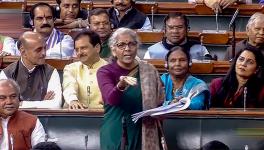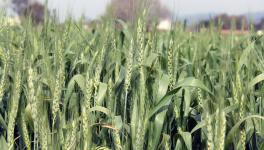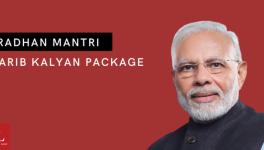Ujjwala, LPG Policy Confine Women to Dark Smoke Chambers

Image Courtesy: Pexels
Prime Minister Narendra Modi claimed at the Pradhan Mantri Ujjwala Yojana (PMUY) launch in Uttar Pradesh’s Ballia district on May 1, 2016: “The scheme will not only help reduce cost for each family but also lead to improvement in women’s health.”
Modi said that the experience of his mother cooking for him on a traditional stove (chulha) inspired him to alleviate the pain of women compelled to use traditional stoves. However, the scheme’s performance and his government’s policy contradict its objectives and the speech, which professed emotional connection and the desire to help poor women. This reality can be better understood from the government data rather than its narrative.
Government Data bely claims
The National Statistical Office’s (NSO) 2019 figures showed that households in rural areas and deprived communities continue to have restricted access to LPG. The NSO’s Time Use Survey revealed that 47% of rural households are still dependent on wood and dung cakes, exposing women to smoke and harmful pollutants and resulting in severe and long-term health issues.
Besides, gender norms burdening women with gathering fuel for traditional stoves prevent them from accessing education, jobs and timely medical care. In contrast, a higher proportion of urban households relied on LPG as cooking fuel. While 86% of urban households used LPG, only 7% relied on wood and dung cake.
In rural India, only one-third of Scheduled Tribe (ST) households and one-half of Scheduled Caste (SC) households used LPG as the primary cooking fuel. For Other Backward Classes (OBC) and “other” category (apart from STs, SCs and OBCs), the corresponding proportions stood at 55% and 59%, respectively. However, it was found that a comparatively higher proportion of SC and ST urban households were dependent on non-LPG cooking sources.
The NSO findings sharply contrast Modi’s claims and the Centre’s yardstick to declare PMUY a success. Under the scheme, 7.19 crore connections were issued till March 31, 2019, increasing the countrywide LPG coverage from 61.90% in May 2016 to 94.30 % in April 2019. In a written reply to the Rajya Sabha in February 2021, the Union minister for petroleum and natural gas pegged the all-India LPG coverage at 99.5%.
The high decibel celebration around the rapid increase in the proportion of households with LPG connection camouflages a fundamental issue: Are people using LPG for cooking?’ The near-universal LPG coverage would be a mere gimmick if people don’t use these connections for the objectives mentioned in the scheme.
The survey shows that despite the near 100% LPG coverage, a significant portion of households, especially in rural areas, cannot use LPG for cooking. The Comptroller and Auditor General of India’s 2019 PMUY report, which provides data from 2016-17 till 2018-19, revealed a growing divergence between LPG coverage and average refill consumption.
The report highlights two issues: LPG cylinder use by domestic connection holders has been declining consistently, and many of the scheme’s beneficiaries cannot refill cylinders. The average annual refill consumption for PMUY stood at 3.9% in 2016-17 and slumped to 2.98% during 2018-19.
In a reply to the Rajya Sabha, the ministry of petroleum and natural gas said that the average annual refill consumption by PMUY consumers rose marginally to 3.01% in 2019-20, saw a substantial increase to 4.39% in 2020-21 and slumped to 3.66% again in 2021-22 (till February 2022).
The abrupt rise in 2020-21 could be attributed to the provision of three free refills per user under the Pradhan Mantri Garib Kalyan Yojana (PMGKY), announced in 2020. More than 14.17 free refills were provided under PMGKY. The drop in average annual refill in 2021-22 in the backdrop of the end of free provision of cylinders stresses the impact of the refill cost on the access to LGP.
An analysis of the number of PMUY (Phase 1) beneficiaries who didn’t refill cylinders or refilled them only once revealed a substantially high number of beneficiaries facing barriers to accessing LPG. Out of approximately eight crore beneficiaries in Phase 1, two crore either took no refill or only one (including installation refill) in 2021-22. Moreover, 2.11 crore out of 30.53 crore domestic active consumers had not taken any refill and 2.91 crore had only one.
The persistently low average refill consumption and the high number of consumers who either do not take any refill or take very few refills show the households’ inability to afford regular LPG refills.
FALLING SUBSIDY, RISING PRICES MAJOR HURDLES
Ensuring access to clean cooking fuel, like LPG, requires more than providing connections alone—refills also have to be made affordable for households. The annual fall in average refill consumption clearly indicates that LPG is becoming increasingly inaccessible. The trend has been synchronous with the rising price of LPG refills. In March 2016, the price of a subsidised domestic LPG cylinder (in Delhi) was Rs 513.50. From May 2020, the subsidy was stopped, forcing consumers to buy them at increased market rates, which rose to Rs 1,000 in 2021.
In June 2022, the government announced subsidy only for PMUY beneficiaries. However, instead of providing LPG cylinders at a fixed price, the government now provides consumers with a subsidy of Rs 200 per refill. The steep hike in the price of LPG cylinders and the withdrawal of the subsidy mostly impact relatively poor households.
The LPG cylinder price has now been left to the open market devices. Hence, with the subsidy pegged at a fixed amount and the market price of LPG cylinders soaring, the widening gap between market price and subsidy falls burdensomely on households consuming LPG. The impact of the increasing financial burden greatly limits the capacity of poor households to refill cylinders.
The objective of providing access to clean fuel and safeguarding women’s health through PMUY contradicts government policies that cause the price of LPG cylinders to shoot through the roof. In effect, this deprives households of access to a clean cooking fuel. The pain of women that Modi claimed to help assuage with the help of PMUY has instead been aggravated by the withdrawal of the subsidy.
The Ujjwala (bright) scheme, combined with the government’s policy on domestic LPG, has actually confined women to the dark smoke chambers of choolhas. Therefore, the PMUY’s failure in achieving its objectives has added the scheme to the list of several other gimmicks that resulted in the opposite of what their names suggest.
The writer is a researcher at Tri-continental Institute for Social Research.
Get the latest reports & analysis with people's perspective on Protests, movements & deep analytical videos, discussions of the current affairs in your Telegram app. Subscribe to NewsClick's Telegram channel & get Real-Time updates on stories, as they get published on our website.























